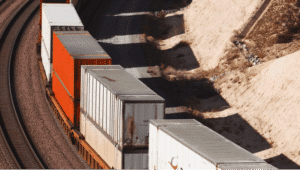Here’s my beef!
An F&L The European Freight and Logistics Leaders’ Forum series of short personal comments on the global freight logistics market
Sascha Tilli, Senior Vice President Commercial, Central Europe, DP World
Short term thinking won’t solve Central Europe’s freight system
 Central Europe’s freight system faces structural limits – landlocked markets, patchy rail, diverging national rules, frequent industrial action, and labour shortages – now colliding with a harsher macro climate. Tariff walls are top of mind for businesses, and many are seeking ways to safeguard their bottom line – whether through rerouting flows in the short term or localised manufacturing by the end of the decade.
Central Europe’s freight system faces structural limits – landlocked markets, patchy rail, diverging national rules, frequent industrial action, and labour shortages – now colliding with a harsher macro climate. Tariff walls are top of mind for businesses, and many are seeking ways to safeguard their bottom line – whether through rerouting flows in the short term or localised manufacturing by the end of the decade.
But short-term tactics are no substitute for long-term planning. Real resilience comes from projects started years in advance and designed to absorb disruption long before it happens.
Planning for resilience
Resilience, much like flood defence, depends on works started before the forecast turns red. Over the past decade DP World has tried to build that sort of headroom. London Gateway, for instance, was conceived in the early 2000s, and today, work is under way on a £1 billion expansion that includes two new shipping berths, taking the total to six berths able to receive the world’s largest container ships. For another example, we might look further afield to Southern Africa, where we recommend shippers bound for Johannesburg to route through Maputo in Mozambique, shaving days and congestion off every box. The principle is the same: commit capital ahead of demand, create an alternative, and let demand follow.
In Central Europe the same logic applies to multimodal options like rail. A shuttle linking Hamburg with southern Germany began running months before diesel costs spiked; it is already running three times per week. While we prepare for the future, our teams across Central Europe are already working around the clock to manage present-day disruptions with minimal impact on trade. These are not heroic one offs; they are levees built before the flood.
Technology as a force multiplier
 Physical capacity, however, is only half the story. A network becomes resilient when hard assets mesh with data-led technologies. Digital tools like DP World’s CARGOES suite can route cargo the moment disruption strikes and give an indication of alternative terminals before competitors even notice the breach. Load optimisation software eliminates wasted space, trimming both cost and carbon – an essential lever while shippers postpone their own green capital expenditure in response to a challenging economic climate.
Physical capacity, however, is only half the story. A network becomes resilient when hard assets mesh with data-led technologies. Digital tools like DP World’s CARGOES suite can route cargo the moment disruption strikes and give an indication of alternative terminals before competitors even notice the breach. Load optimisation software eliminates wasted space, trimming both cost and carbon – an essential lever while shippers postpone their own green capital expenditure in response to a challenging economic climate.
The case for early investment
Sequencing lies at the core of what holds freight back in Central Europe. Too many projects wait for demand to become a bottleneck before concrete is poured. Optionality and agility must be designed in, not patched on.
We understand that resilience can’t be built in isolation. It demands collaboration – with governments who enable modal shifts, with clients who share operational data, and with regional partners aligning for efficiency. So, what I’m getting at is a call for a new baseline. Governments, investors and operators should judge projects on the value of avoided disruption, not just immediate throughput. Accounting rules might struggle with that framework, but experience – the pandemic, a grounded ship in the Suez Canal, strikes along the Rhine – suggests the cost of inaction is larger still.
The true value of infrastructure lies in being ready before disruption strikes, not scrambling to respond once challenges have already hit. Our goal is not perfection, but progress, agility, and resilience.






